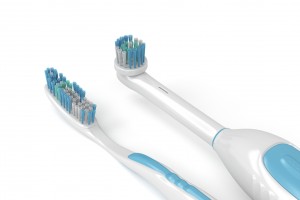Toothbrushes are 25 percent of our dental care routines but anyone who has ever walked into a drugstore knows how difficult it is to shop for a toothbrush. There are so many different options to choose from: hard, soft, or medium bristles, tongue scrubbers, electric ones, ones that just kind of vibrate but don’t move, and the manual ones with the little plastic arms that look vaguely useful but are really just weird. So short of play “Eenie Meenie Miney Mo”, how do you choose the right one for you?
Types of Manual Toothbrushes
There are actually several different kinds of toothbrush heads. There is the conventional toothbrush that is either square or rectangle and very effective in cleaning the tooth surface. Diamond heads brushes are narrower but designed to access the posterior teeth better. As we age, the head of our brushes should grow as well. Zero to two years old should have a toothbrush about 15mm long and an adult’s should be about 25mm long.
If you have ever looked at toothbrushes, you’ll notice the bristle patterns are always different. Some have block patterns, wavy or V-shaped patterns for better contact with adjacent teeth, multilevel trim patterns to brush “hard to clean” areas, and criss-cross patterns to get plaque. The softness in the bristles are to stop the user from harming their teeth and gums. Using hard bristles can have adverse effects to the teeth and gums. Most dentists will recommend soft or extra soft bristles for people with sensitive teeth or gums or for people recovering from dental surgery.
Electric and Battery Powered Toothbrushes
Anyone who has ever used a battery powered toothbrush is familiar with the vibrations. These toothbrushes are just like a manual brush but with the added vibrations. If you want something with a bit more power to it, try an actual electric toothbrush. Electric brushes allow the user to choose brush modes for sensitive teeth or gum-massaging action. They have timers to help you keep track of your oral hygiene and pressure sensors if you are brushing too hard. They also oscillate or have sonic technology to help with your smile.
Manual Vs. Electronic
When it comes to choosing a toothbrush, it is always best to ask your dentist which type of bristle is best for your teeth and gums. With that knowledge, think about expense, what you want out of a brush, and the features you want. If you want a basic toothbrush where you are in control, go old school with a manual brush but if you are looking for something with different settings, choose an electronic brush. If you have any questions, ask one of our dentists on your next visit.
Leikin & Baylin Dental Care of Catonsville
If you have questions about your dental hygiene routine or you just need to schedule a cleaning, let our friendly and professional staff help restore your dental health. Call today at 410-747-1115, or submit any questions by visiting CatonsvilleDentalCare.com.

